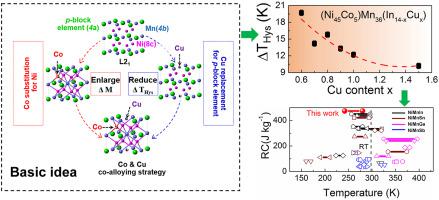Intermetallics ( IF 4.3 ) Pub Date : 2020-12-25 , DOI: 10.1016/j.intermet.2020.107063 Hai-Le Yan , Xiao-Ming Huang , Jin-Han Yang , Ying Zhao , Feng Fang , Nan Jia , Jing Bai , Bo Yang , Zongbin Li , Yudong Zhang , Claude Esling , Xiang Zhao , Liang Zuo

|
Due to the existence of the magnetic-field-induced reverse martensitic transformation, the Ni–Mn–Z alloys where Z is the p-block element of In, Sn or Sb exhibit several state-of-the-art magnetoresponsive properties. From the perspective of practical application, a major challenge of this compound is to strengthen the ferromagnetism and reduce the transitional hysteresis ΔTHys simultaneously. In this work, we report an alloying strategy to this issue, i.e., the partial substitutions of Co and Cu for Ni and the p-block element, respectively, by a combined study of experiment and ab-initio calculation in the Ni45Co5Mn36In14–xCux (x = 0–1.5) alloys. Results show that the Cu replacement for the p-block element (In) can effectively reduce ΔTHys owing to the improved geometrical compatibility between austenite and martensite. Moreover, the adopted alloying strategy of Cu hardly weakens the strong ferromagnetism of Ni(Co)–Mn–In, since the magnetism exhibits a weak dependence on the p-block element compared with Mn and Ni. The maximum reversible magnetic entropy change of the Ni45Co5Mn36In13.3Cu0.7 directionally solidified sample at a magnetic field of 5 T is 13.8 J·kg−1·K−1. The refrigeration capacity RC and effective refrigeration capacity RCeff equal to 473.7 J·kg−1 and 270.2 J·kg−1, respectively. Both values belong to the highest one in the Ni–Mn-based alloys. Additionally, the working temperature window of the magnetocaloric effect is as wide as ~40 K. This work is expected to promote the design of advanced metamagnetic shape memory alloys.
中文翻译:

Ni-Mn基超磁形状记忆合金中同时优化磁和磁滞的策略
由于磁场引起的马氏体逆相变的存在,其中Z是In,Sn或Sb的p元素的Ni-Mn-Z合金表现出几种最新的磁响应特性。从实际应用的角度来看,该化合物的主要挑战是增强铁磁性并同时降低过渡磁滞ΔTHys。在这项工作中,我们报告了针对该问题的合金化策略,即通过在Ni 45 Co 5中进行实验和从头算计算的组合研究,分别将Co和Cu分别置换为Ni和p嵌段元素。锰36 In14–x铜x(x = 0–1.5)合金。结果表明,由于改善了奥氏体和马氏体之间的几何相容性,用铜代替p块元素(In)可以有效降低ΔTHys。此外,采用的铜合金化策略几乎不会削弱Ni(Co)-Mn-In的强铁磁性,因为与Mn和Ni相比,磁性对p阻挡元素的依赖性较小。最大可逆磁熵变在5 T的磁场下,定向凝固的Ni 45 Co 5 Mn 36 In 13.3 Cu 0.7样品的当量为13.8 J·kg -1 ·K -1。制冷量RC和有效制冷量RC eff分别等于473.7 J·kg -1和270.2 J·kg -1。这两个值均属于Ni-Mn基合金中的最高值。此外,磁热效应的工作温度范围高达〜40K。这项工作有望促进先进的亚磁形状记忆合金的设计。











































 京公网安备 11010802027423号
京公网安备 11010802027423号